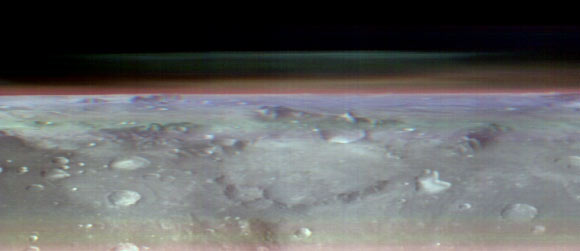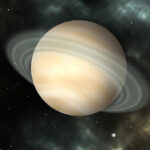In an operation that took mission scientists three months to plan, NASA’s Mars Odyssey orbiter captured a series of panoramic images that showcases the curving Martian landscape below gauzy layers of clouds and dust.
This image of the Martian horizon was captured by the THEMIS camera on NASA’s Mars Odyssey orbiter. Image credit: NASA / JPL-Caltech / ASU.
“If there were astronauts in orbit over Mars, this is the perspective they would have,” said Mars Odyssey project scientist Jonathon Hill, of Arizona State University.
“No Mars spacecraft has ever had this kind of view before.”
“The reason why the view is so uncommon is because of the challenges involved in creating it.”
The images of the Martian horizon were captured by the Thermal Emission Imaging System (THEMIS) onboard Mars Odyssey.
They were taken from an altitude of about 400 km (250 miles) — the same altitude at which the space station flies above Earth.
The sensitivity of the THEMIS instrument to warmth enables it to map ice, rock, sand, and dust, along with temperature changes, on the planet’s surface.
It can also measure how much water ice or dust is in the atmosphere, but only in a narrow column directly below the spacecraft.
That’s because THEMIS is fixed in place on the orbiter; it usually points straight down.
The Mars Odyssey scientists wanted a more expansive view of the atmosphere.
Seeing where those layers of water-ice clouds and dust are in relation to each other helps them improve models of Mars’ atmosphere.
“I think of it as viewing a cross-section, a slice through the atmosphere,” said Mars Odyssey project scientist Jeffrey Plaut, of NASA’s Jet Propulsion Laboratory.
“There’s a lot of detail you can’t see from above, which is how THEMIS normally makes these measurements.”
Because THEMIS can’t pivot, adjusting the angle of the camera requires adjusting the position of the whole spacecraft.
In this case, the team needed to rotate the orbiter almost 90 degrees while making sure the Sun would still shine on the spacecraft’s solar panels but not on sensitive equipment that could overheat.
The easiest orientation turned out to be one where the orbiter’s antenna pointed away from Earth.
That meant the team was out of communication with Odyssey for several hours until the operation was complete.
To make the most of their effort, the researchers also captured imagery of the Martian moon Phobos.
This marks the seventh time in 22 years that the orbiter has pointed THEMIS at the moon in order to measure temperature variations across its surface.
“We got a different angle and lighting conditions of Phobos than we’re used to. That makes it a unique part of our Phobos dataset,” Dr. Hill said.
“The new imagery provides insight into the composition and physical properties of the moon.”



